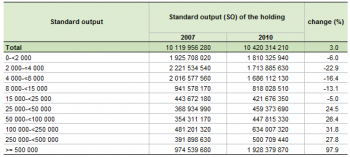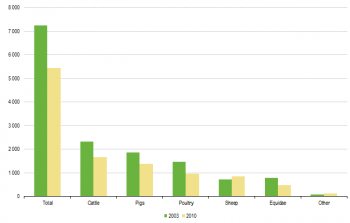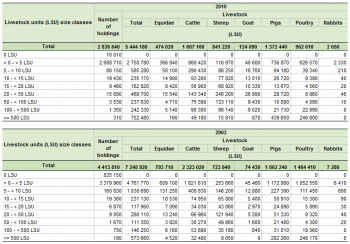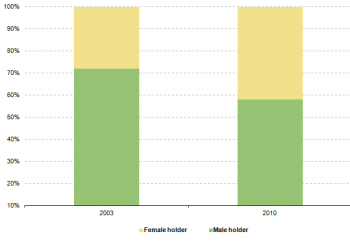Archive:Agricultural census in Romania
- Data from November 2012. Most recent data: Further Eurostat information, Main tables and Database.
This article is part of a series of country-specific essays on the results of the European Union (EU) Farm structure survey (FSS) 2010. The FSS collects information on the structural characteristics of the agricultural holdings (land use, livestock and labour force) and is carried out by all European Union Member States every 10 years as an Agricultural census, with two or three additional, intermediate sample surveys carried out in-between.
The present analysis of the farm structure includes a comparison with the Agricultural census 2000, the first one conducted in Hungary in compliance with the EU regulations. In contrast with the FSS 2010, the Agricultural census 2000 in Hungary did not include information on common land. In order to allow comparison between the two reference years, 2010 data presented throughout this article do not include information on common land when the analysis refers to the two waves of the survey. On the contrary, data on common land are taken into account when the analysis focuses on the most recent data set.

Source: Eurostat (ef_kvaareg) (ef_ov_kvaa) (demo_pjan) and FSS 2003 and 2010

Source: Eurostat (ef_kvaareg) (ef_ov_kvaa) and FSS 2003 and 2010
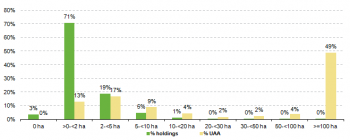
Source: Eurostat (ef_kvaareg) (ef_ov_kvaa)

Source: Eurostat (ef_kvftreg)
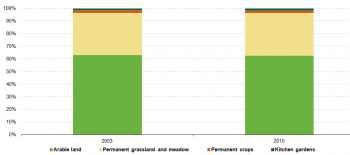
Source: Eurostat (ef_lu_ovcropaa) (ef_oluaareg)
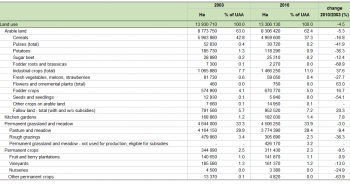
Source: Eurostat (ef_lu_ovcropaa) (ef_oluaareg)

Source: Eurostat (ef_mptenure)

Source: Source: Eurostat (ef_pmhouscatlaa)
Main statistical findings
Key indicators
As exhibited in Table 1, there were 576 790 agricultural holdings in Hungary in 2010; from among the EU Member States, Greece (723 010) and France (489 980) [1] recorded similar values. In Hungary, about 390 000 farms ceased their activities (- 40.3 %) over the 2000-2010 timeframe – far from being a Hungarian peculiarity, this tendency was found to be widespread among the EU-27.
In Hungary, the utilised agricultural area (UAA) slightly increased over the inter-census period (+ 57 250 ha): it indicated the value of 4.6 million hectares and covered about half of the entire Hungarian territory in 2010.
As the number of holdings decreased and the agricultural land increased, the average size of the holdings grew: it almost doubled, from 4.7 ha per farm in 2000 to 8 ha in 2010.
Following a well established European pattern, also in Hungary the number of people regularly working on the farm decreased over the period under analysis (-21.9 %): about 1.5 million people were working on the farms in 2003 [2], whereas only 1.1 million were left in 2010. However, the agricultural labour force still represented 27 % of the active population [3] in 2010 – by far one of the highest shares recorded within the EU-27.
The Hungarian farm animal population indicated the value of about 2.5 million livestock units (LSU) in 2010: compared to 2000, a 20 % decrease was observed (- 613 750 LSU). From among the other EU Member States, Austria (2.5 million LSU) and Greece (2.4 million LSU) recorded similar values.
Regional key indicators
The territorial analysis presented in Table 2 reveals the regional characteristics of the Hungarian agriculture and highlights the major role played by the territories of Észak-Alföld and Dél-Alföld. Indeed, the Northern Great Plain (Észak-Alföld) and the Southern Great Plain (Dél-Alföld) scored the highest values for each of the key indicators analysed (number of holdings, total UAA, livestock population and number of persons working on the farms), and together proved to account for about 45 % of the country’s total value.
In terms of the number of holdings, the territory of Észak-Alföld recorded the highest value (143 910) and accounted for one fourth of the entire population. Further 124 370 farms were registered within the territory of Dél-Alföld in 2010, a value which accounted for 22 % of the Hungarian population of agricultural holdings: the very same share was recorded in Dél-Alföld in 2000. On the other end of the scale, the region of Közép-Magyarország (Central Hungary) recorded the lowest number of farms (46 320) and shared a minor 8 %.
If the agricultural area is taken into account, it is the Southern Great Plain which displayed the highest figure: in 2010, it accounted for 23.5 % of the Hungarian agricultural area as 1.08 million hectares of UAA were recorded within its borders. The Northern Great Plain accounted for a slightly smaller share (22.6 %) with 1.05 million hectares of agricultural land recorded within its territory. In 2000, the territory of Észak-Alföld showed a lower share (21.4 %) and the UAA reported within its borders was found to be below the 1 million hectare threshold. Also in terms of the agricultural area, the region of Central Hungary proved to be marginal, since only 251 900 hectares of agricultural land were recorded within its territory in 2010. Its role within the structure of the Hungarian agriculture appears to have worsened over the years: it accounted for about 7 % of the country’s UAA in 2000, whereas in 2010 it indicated the share of 5.5 %.
In terms of the livestock – measured in livestock units (LSU) – the region of Dél-Alföld proved to be the most important. In 2010, 732 180 LSU were recorded within its territory, a value which proved to correspond to about 30 % of the country’s population of farm animal. As exhibited in Table 2, 630 810 LSU were recorded within the territory of Észak-Alföld, a value which accounted for about one fourth of the Hungarian farm animal population in 2010 – the corresponding value was 22 % in 2000. The regions of Közép-Dunántúl (11.7 %), Dél-Dunántúl (11.4 %) and Nyugat-Dunántúl (10.1 %) all recorded similar values, whereas the territory of Central Hungary recorded the smallest absolute number (112 160) and accounted for a marginal 4.5 %.
In terms of the agricultural labour force, the Northern Great Plain (21 %) and the Southern Great Plain (25 %) together accounted for 46 % of the Hungarian regular labour force: about 521 440 people were recorded as working on the farms within their borders in 2010. The region of Dél-Dunántúl (13 %), Észak-Magyarország (13 %), Nyugat-Dunántúl (11 %) and Közép-Dunántúl (10 %) recorded double digit shares, whereas the territory of Közép-Magyarország registered a lower share (7.5 %) in 2010.
Agricultural holdings
As exhibited in Figure 1, the Hungarian population of agricultural holdings is dominated by two size classes: small holdings with less than 2 hectares of agricultural area, and farms with 50 hectares or more of agricultural land. Despite the fact that they indicated the value of 455 530 and represented 79 % of the entire population of farms, holdings with less than 2 hectares of UAA were found to cover only 3 % of the Hungarian agricultural land in 2010. On the other end of the scale, farms with 50 hectares or more of agricultural land represented a marginal 2 % of the population of holdings (13 860) but they were found to account for 75 % of the country’s agricultural land (3.5 million ha) in 2010.
This type of polarisation of the agricultural structure has been observed in other eastern European countries and partially derives from the process which took place in the 1990’s, when the restoration of the land property to the former owners or a division among the members of the agricultural cooperatives was implemented in many Eastern European Member States (Banski, J.) [4]
See detailed data at NUTS 2 level for 2000 and2010
Economic size of the farm
As exhibited in Table 3, the economic size of the Hungarian agricultural holdings indicated the value of EUR 5 237 million in 2010 – from among the other EU Member States, Austria (EUR 5 879 million) and Portugal (EUR 4 640 million) recorded similar values. In Hungary, the standard output, which is calculated by adding all the standard output (SO) per hectare of crop and per head of livestock of the farms, increased by 12.5 % over the 2007-2010 timeframe. An increase was recorded for most classes of farms, with the exception of the smallest ones – holdings with less than EUR 2 000 of SO – whose value actually decreased by 8.6 %. On the contrary, the highest growth (+44.2 %) was recorded by farms with an economic size of EUR 100 000 to 249 999: their value increased from EUR 377 million in 2007 to 544 million in 2010.
The biggest class of farms, agricultural holdings with EUR 500 000 or more of SO, proved to be by far the most important, as alone it accounted for 43 % of the Hungarian standard output in 2010: +3.8 % compared to 2007.
From among the Hungarian regions, the Southern Great Plain recorded the highest value (EUR 1 389 million), corresponding to 26 % of the Hungarian SO. The Northern Great Plain (EUR 1 167 million) was found to account for 22.3 %; the territory of “Del-Dunántúl” recorded the third highest share (14.5 %), followed by the neighbouring regions of “Nyugat-Dunántúl” (11.7 %) and “Közép-Dunántúl” (11.6 %).
See detailed data at NUTS 2 level for 2010 and 2007
Agricultural holding by main type of farming
If the number of holdings and the main type of farming are taken into account, there are four that appear to be the most common in Hungary (see Figure 2): holdings specialised in poultry, which accounted for 20 % of the total population of farms in 2010; those dedicated to various crops and livestock combined (13 %); the ones specialised in cereal, oilseed and protein crops (13 %); and farms dedicated to various granivores combined (10 %).
As exhibited in Figure 3, the ranking looks different in terms of the economic size as only two types of production scored double digit percentages in 2010: agricultural holdings specialised in cereals, oilseed and protein crops, which were found to account for 26 % of the Hungarian SO, and farms dedicated to poultry, which shared 19 %.
See detailed data at NUTS 2 level for 2010
Land use
The Utilised Agricultural Area (UAA) is the total area used by the farm, regardless of the type of tenure or whether it is used as a part of common land. It includes four major components: arable land, permanent grassland and meadow, permanent crops and kitchen gardens.
In Hungary, the agricultural area was mostly taken up by arable land (82.3 %) and permanent grassland and meadows (14 %), with permanent crops sharing a marginal 3.3 % in 2010. Over the period under analysis, the area of permanent grassland and meadow increased by 9.7 % (+57 250 ha), whereas the arable land remained quite stable, only gaining 18 850 hectares.
See detailed data at NUTS 2 level for 2000 and 2010
Arable land
As exhibited in Table 4, in 2010 the Hungarian arable land was mainly dedicated to the production of cereals (2.4 million ha), industrial crops (753 550 ha) and fodder crops (284 770 ha); also fallow land recorded remarkable values, as it took up 5.6 % of the country’s agricultural area (260 040 ha). Between the two reference years, the production of cereals lost 245 390 hectares, whereas the cultivation of industrial crops gained 350 690 hectares of agricultural land; both fodder crops and the area dedicated to fallow land remained fairly stable.
See detailed data at NUTS 2 level for 2000 and 2010
Permanent grassland
Over the inter-census timeframe, the area of permanent grassland increased by 9.7 %: in absolute terms, it gained 57 250 hectares. The area dedicated to pasture and meadow lost 379 320 hectares, whereas the land on which rough grazing is practised gained 436 580 ha.
See detailed data at NUTS 2 level for 2000 and 2010
Livestock
Statistics on livestock use two different units of measurement, the number of heads (number of animals) and the livestock unit (LSU), with the latter allowing comparison between different types.
In 2010, 381 650 holdings were found to farm about 2.5 million LSU in Hungary (see table 5). Poultry constituted the vast majority of this livestock (976 100 LSU), representing 39 % of the entire Hungarian farm animals population: the corresponding share was 32 % in 2000. Despite a decrease of 37 % compared to 2000, pigs recorded a remarkable share (32 %) and indicated the value of 793 240 LSU in 2010. The cattle recorded the only other double digits share (21.2 %): in absolute terms, it indicated the value of 525 410 LSU (-18 % compared to 2000).
Although their number almost halved over the inter-census timeframe, holdings with livestock still accounted for 66.2 % of the Hungarian population of farms in 2010: the corresponding share was 76 % in 2000.
In terms of the livestock population, the territories of Észak-Alföld and Dél-Alföld proved to be the most important: in 2010, 26 % of farms with livestock were recorded in Észak-Alföld, whereas Dél-Alföld accounted for 24 % of holdings with farm animals. In addition, the Great Northern Plain and the Great Southern Plain proved to host the highest shares of poultry and pigs, the two most common types of livestock. The Great Northern Plain accounted for the highest share of pigs (28.1 %), whereas the highest percentage of poultry (36.7 %) was registered within the borders of the Great Southern Plain.
See detailed data at Nuts 2 level for 2010 and 2000
Labour force
According to the FSS 2010, 1.1 million people were regularly working in the agricultural sector in Hungary (see Table 6). As observed in many EU Member States, also in Hungary the agricultural labour force decreased (-21.9 %) over the period under analysis: in absolute terms, 321 190 persons stopped working on the farms between 2003 and 2010. The fall in the agricultural labour force looks very similar if the annual work unit (AWU) is taken into account, in which case figures changed from 511 070 AWU in 2003 to 402 970 AWU in 2010 (- 21.1%).
The gender cleavage among the sole holders showed signs of reduction, as 79 % of the sole holders proved to be men in 2003, whereas the male share indicated the value of 77 % in 2010.
See detailed data at NUTS 2 level on holders' age and gender for 2010 and 2003
See detailed data at NUTS 2 level on type of labour force for 2010 and 2003
Management practices
Type of tenure
As exhibited in Table 7, half of the Hungarian agricultural land (2.3 million ha) proved to be farmed by the tenants in 2010. Furthermore, most of the regions recorded shares higher than the national average, with the only exceptions being the territories of Észak-Alföld (43.2 %) and Dél-Alföld (41.2 %).
On the contrary, about 2 million hectares of Hungarian agricultural land (43.5 %) were found to be farmed by the people who actually owned that land in 2010: the highest shares were recorded in the Northern Great Plain (50.1 %) and the Southern Great Plain (52.9 %).
The land utilised in partnership by the landlord and the sharecropper under a written or oral share-farming contract was found to cover a mere 6.5 %.
Animal housing
According to the Agricultural census 2010, there were 19 120 holdings farming 707 400 heads of cattle in Hungary; from among the other European Member States, Sweden (21 590) and Norway (16 900) recorded similar values.
In terms of the number of farms, the most common type of animal housing was found to be the one recorded under the general “other” category (9 190 holdings), followed by the housing where the cattle are tied stable with solid dung and liquid manure, which was recorded in 8 030 holdings.
On the contrary, if the number of places is taken into account, the housing where the animals are free to move with solid dung and liquid manure was found to be the most common (354 620 places). When analysing data on animal housing, it must be noted that holdings could record more than one type of housing.
Other gainful activities
According to the FSS 2010, there were 47 270 farms with other gainful activities in Hungary. These holdings, which accounted for 8 % of the entire population of farms, registered activities other than farm work, directly related to the holding and having an economic impact on it; within the context of the EU-27, France (48 350) and Norway (25 500) recorded similar values.
Information on other gainful activities was collected by eleven category types depending on their characteristics – one holding could register more than one activity. Processing of farm products (26 430 farms) proved to be the most common type of extra activity, followed by contractual work (13 450 farms), which could take the form of contractual agricultural work (13 160) and contractual non-agricultural work (2 330 farms).
Among the Hungarian regions, the highest number of holdings with extra source of income (10 770) was recorded within the territory of Észak-Alföld: it accounted for 22 % of the total population of farms with other gainful activities.
See detailed data at NUTS 2 level for 2000
Data sources and availability
Methodological notes Hungary – Agricultural census 2010
The Agricultural Census 2010 was the first one to be conducted after Hungary’s accession to the European Union (2004) and the second one carried out in compliance with the EU legislation. The Hungarian Central Statistical Office was the responsible body.
Survey on agricultural production methods (SAPM)
In 2010 a unique survey was carried out together with the Agricultural census, the Survey on agricultural productions methods (SAPM). This survey collected data at regional level needed to establish agri-environmental indicators as indicated in COM final 508/2006 and to evaluate the greening of the Common agricultural policy.
Data were collected according to the specifications listed in Annex V of the above mentioned regulation, namely data on tillage methods, soil conservation, landscape features, animal grazing, animal housing, manure application, manure storage and treatment facilities and irrigation.
In Hungary, the SAPM was conducted as an exhaustive survey with regard to the agricultural enterprises. On the contrary, the SAPM was carried out as a sample survey in the case of private holdings. A random selection method, based on the enumeration districts, was employed to select 3 475 enumeration districts; all the households within the selected districts were surveyed.
Reference period
Data on the structure of Hungarian agriculture were collected as of the 1st of June 2010. Information on the labour force, non-agricultural activities and the Survey on Agricultural Production Methods was collected with reference to the 12 months prior to this reference date. Data on the rural development and irrigated area refer to the 2008-2010 timeframe.
Threshold for agricultural holdings
In Hungary, all agricultural enterprises which carried out activities were surveyed in 2010. In the case of private agricultural holdings, only farms with at least 1 500 square metres of productive land area were included in the census. Moreover, farms falling below this threshold but complying with a set of different physical thresholds (related to the square metres of certain types of crops or heads of cattle) were also included in the target population.
Common land
Common land is the land that does not directly belong to any agricultural holding but on which common rights apply. It can consist of pasture, horticultural or other land. The treatment of the common land used by an agricultural holding might differ from country to country.
In Hungary, common grassland was not considered as agricultural area until 2007. Thus, information on common land was included for the first time within the context of the FSS 2010: it indicated the value of about 74 000 hectares (2 % of the Bulgarian agricultural area).
Geo-reference of the holding
In Hungary, information on the location of the farms was obtained through the topographical lot number, the Integrated Administrative Control System (IACS) block identifier of the place where the main agricultural production is carried, or through the address of the holding.
Economic size
From FSS 2007 onwards, the Standard output (SO), a new classification of the economic size of the holding, is used. The SO has replaced the Standard gross margin (SGM) used before. Nonetheless, for comparability reasons, in FSS 2007 both classifications are available.
Other methodological issues
In Hungary, the Agricultural census 2000 did not include information on common land. Since data on common land were included in the FSS 2010, information on common land was filtered out of the 2010 data set when the two waves of the FSS were compared. On the contrary, whenever the present analysis took into account only the most recent data, figures on common land were included. Moreover, due to methodological reasons, the reference years for data on the Hungarian agricultural labour force are 2003 and 2010.
Context
European Commission Rural development policy aims to improve competitiveness in agriculture and forestry, the environment and the countryside, as well as to improve the quality of life in rural areas, and to encourage the diversification of rural economies.
As agriculture has been modernised and the importance of industry and services within the economy has increased, agriculture has become much less important as a source of jobs. Consequently, increasing emphasis is placed on the role farmers can play in rural development, including forestry, biodiversity and the diversification of the rural economy, in order to create alternative jobs and provide environmental protection in rural areas.
The FSS continues to adapt in order to provide timely and relevant data to help analyse and follow these developments.
Further Eurostat information
Publications
- Agriculture, fishery and forestry statistics — Main results – 2010-11 - 2012 edition
- Farm Structure Survey in Hungary - 2007 - Issue number 7/2009
- Farm Structure in Hungary - 2005 - Issue number 22/2006
- Structure of Agricultural Holdings - Hungary 2003 - Statistics in focus 27/2004
Main tables
- Agriculture, see:
- Structure of agricultural holdings (t_ef)
Database
- Agriculture, see:
- Structure of agricultural holdings (ef)
Dedicated section
Methodology / Metadata
- Structure of agricultural holdings (ESMS metadata file - ef_esms)
- Methodological Report - FSS 2010 Hungary
- Methodological Report - FSS 2007 Hungary
Source data for tables and figures (MS Excel)
Other information
- Regulation 1166/2008 of 19 November 2008 on farm structure surveys and the survey on agricultural production methods and repealing Council Regulation 571/88
- Regulation 1200/2009 of 30 November 2009 implementing Regulation 1166/2008 on farm structure surveys and the survey on agricultural production methods, as regards livestock unit coefficients and definitions of the characteristics
See also
- census 2010 Agricultural census 2010
- structure All farm structure articles by country
- structure statistics Farm structure statistics
External links
Notes
- ↑ The value does not take into account data on common land.
- ↑ Due to methodological reasons, the reference years for data on the Hungarian agricultural labour force are 2003 and 2010.
- ↑ A value calculated over the total number of active people aged 15 to 64, as it is reported by the 4th quarter 2009 of the EU Labour force survey (LFS) Population by sex, age, nationality and labour status (1 000)(lfsq_pganws).
- ↑ Jerzy Banski, Agriculture of central Europe in the period of economic transformation
